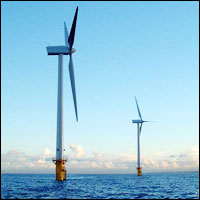Power and Electrical Engineering
This topic covers issues related to energy generation, conversion, transportation and consumption and how the industry is addressing the challenge of energy efficiency in general.
innovations-report provides in-depth and informative reports and articles on subjects ranging from wind energy, fuel cell technology, solar energy, geothermal energy, petroleum, gas, nuclear engineering, alternative energy and energy efficiency to fusion, hydrogen and superconductor technologies.

World´s Largest Solar Factory Opens In Japan
In this world of increasing worries over dependence on foreign oil, environmental degradation and the vulnerability of power networks, many people are calling for greater use of clean energy alternatives such as solar power. It is encouraging therefore to note the completion of the world´s largest factory for solar panels, built by MSK, Japan´s leading specialist solar manufacturer.
Tokyo-based MSK Corporation has opened the doors to its new production facility located in Nagano, Japan.

Scientists create world’s most efficient light-bulb
Scientists have successfully produced the most efficient light bulb ever – but on the microscopic scale. Researchers at Trinity College, Dublin have discovered a technique which significantly improves the output of light from quantum dots, and also allows their light to be focussed and manipulated easily. Their findings are published today in the Institute of Physics journal Semiconductor Science and Technology.
Dr Yuri Rakovich and Dr John Donegan from Trinity College, Dublin working with

Tungsten photonic crystals may answer the need for more power in advanced electrical applications
Technical Insights’ High Tech Materials Alert
Scientists have discovered that when lattice tungsten filaments are heated, they are capable of emitting greater energy than solid tungsten filaments.
“Because of this significant advance, lattice tungsten filaments will likely meet the increasing power requirements of high-tech electrical systems, such as those in hybrid electric cars, sophisticated boats, engines, and industrial waste heat-driven electrical generators,” sa

New solid-state power switch safeguards electric service
Electricity moves across miles in seconds to power manufacturing and utilities nationwide. But, for all its speed, the loss of just fractions of seconds of electric power is costing the U.S. economy $100 billion a year.
“The nation’s electric grid is operating so close to capacity that many of today’s electric load demands for fast and dynamic voltage support cannot be provided fast enough,” says Alex Huang, professor of electrical and computer engineering at Virginia Tech.

"Spintronics" could enable a new generation of electronic devices
Moore´s Law – a dictum of the electronics industry that says the number of transistors that fit on a computer chip will double every 18 months – may soon face some fundamental roadblocks. Most researchers think there´ll eventually be a limit to how many transistors they can cram on a chip. But even if Moore´s Law could continue to spawn ever-tinier chips, small electronic devices are plagued by a big problem: energy loss, or dissipation, as signals pass from one transistor to the next. Line up all t

Space shows way to Europe’s renewable energy future
How can we more effectively harness the free and endless energy resources of the Sun, wind and water? One answer is orbiting above us.
Satellites provide us with a wide variety of data that can help with many aspects of the building and management of renewable energy plants. ESA recently held a workshop at its Frascati-based centre in Italy, attended by representatives of the Earth Observation (EO) service industry together with renewable energy companies and utilities to explore how